Tendon Property
Define the tendon properties such as tendon area and instantaneous prestress losses.
From the Main Menu select Load > Temp./Prestress > Prestress Loads > Tendon Property.
![]() To define new or additional tendon properties
To define new or additional tendon properties
Click ![]() in the Tendon Property dialog box and enter the following:
in the Tendon Property dialog box and enter the following:
 Tendon Name
Tendon Name
tendon name being defined
 Tendon Type
Tendon Type
Define the tendon type among Pre-Tension, Post-Tension and External.
Internal (Pre-Tension): Prestressing tendons prior to casting concrete, which transmits prestress through bonding between concrete and tendons
Internal (Post-Tension): Post-tensioning tendons through hardened concrete members - tendons are gradually stressed and anchored to the members.
External: Tendons are placed external to concrete members and stressed.
Note 1
Depending on the Tendon Type (Pre-Tension, Post-Tension and External), the entry fields for variables related to tension losses in tendons and duct diameter are either activated or inactivated.
Note 2
If the tendon placement location is External, the tendon is displayed as a straight line in ![]() Display.
Display.
 Material
Material
Select the material properties of the tendon. Click ![]() to the right to add new or modify/delete previously defined tendon properties.
to the right to add new or modify/delete previously defined tendon properties.
 Total Tendon Area
Total Tendon Area
Specify the total area of the tendon. You may either directly specify the cross-sectional area or click ![]() to enter the standard cross-sectional area and the number of strands for auto-calculation of the total area.
to enter the standard cross-sectional area and the number of strands for auto-calculation of the total area.
|
|
Tendon Type |
|||||
|
12.4 |
12. 7B |
15. 2B |
G15. 2 |
28. 6 |
||
|
Number of Strands |
EA |
12 |
12 |
12 |
19 |
1 |
|
Tendon Area |
CM2 |
11.148 |
11.8452 |
16.644 |
26.353 |
5.324 |
|
Duct Diameter |
CM |
6.8 |
6.8 |
7.8 |
11.5 |
5 |
|
Wobble Friction Factor λ |
/m |
0.004 |
0.004 |
0.004 |
0 |
0.004 |
|
Curvature Friction Factor μ |
/rad |
0.3 |
0.3 |
0.3 |
0.3 |
0.3 |
|
Anchorage Slip |
mm |
11 |
12 |
11 |
5 |
5 |
|
Relaxation |
% |
5 |
5 |
5 |
1.5 |
2.5 |
|
Young's Modulus |
N/mm2 |
200000 |
200000 |
200000 |
200000 |
200000 |
|
Yield Strength σpy |
N/mm2 |
1450 |
1600 |
1600 |
1600 |
1500 |
|
Tensile Strength σpu |
N/mm2 |
1700 |
1850 |
1850 |
1860 |
1800 |
 Duct Diameter
Duct Diameter
When the Tendon Type is Post-Tension, input for the diameter of duct is required. Based on the tendon area, the duct diameter is automatically calculated, which is then referred to for duct diameter input.
 Strand Diameter
Strand Diameter
When the Tendon Type is Pre-Tension, the diameter of strand should be entered. The program automatically calculates the diameter of strand corresponding to the specified Total Tendon Area. The diameter of the strand is used to compute Transfer Length.
 Relaxation Coefficient: C
Relaxation Coefficient: C
Select Magura or CEB-FIP for the method of applying relaxation. To ignore the steel relaxation, uncheck the box.
-
When European is selected
 Ultimate Strength
Ultimate Strength
 Yield Strength
Yield Strength
 Curvature Friction Factor
Curvature Friction Factor
to account for friction loss due to the curvature of tendons
 Wobble Friction Factor
Wobble Friction Factor
To account for straightness/length effect (imperfection in alignment along the length of tendon, regardless of straight or draped alignment)
 Anchorage Slip (Draw in)
Anchorage Slip (Draw in)
Tendon slippage at the anchor
Begin: slippage at the beginning of tendon if tensioned here
End: slippage at the end of tendon if tensioned here
![]() Bond Type
Bond Type
Bonded: Section properties reflect the duct area after grouting
Unbonded: Section properties exclude the duct area.
![]() To modify the previously entered tendon data
To modify the previously entered tendon data
Select the tendon from the list in the Tendon Property dialog box and click ![]() to change any relevant data.
to change any relevant data.
![]() To delete the previously entered tendon data
To delete the previously entered tendon data
Select the tendon from the list in the Tendon Property dialog box and click ![]() to eliminate any relevant data.
to eliminate any relevant data.
Q1. What are the considerations in the program regarding external tendons?



